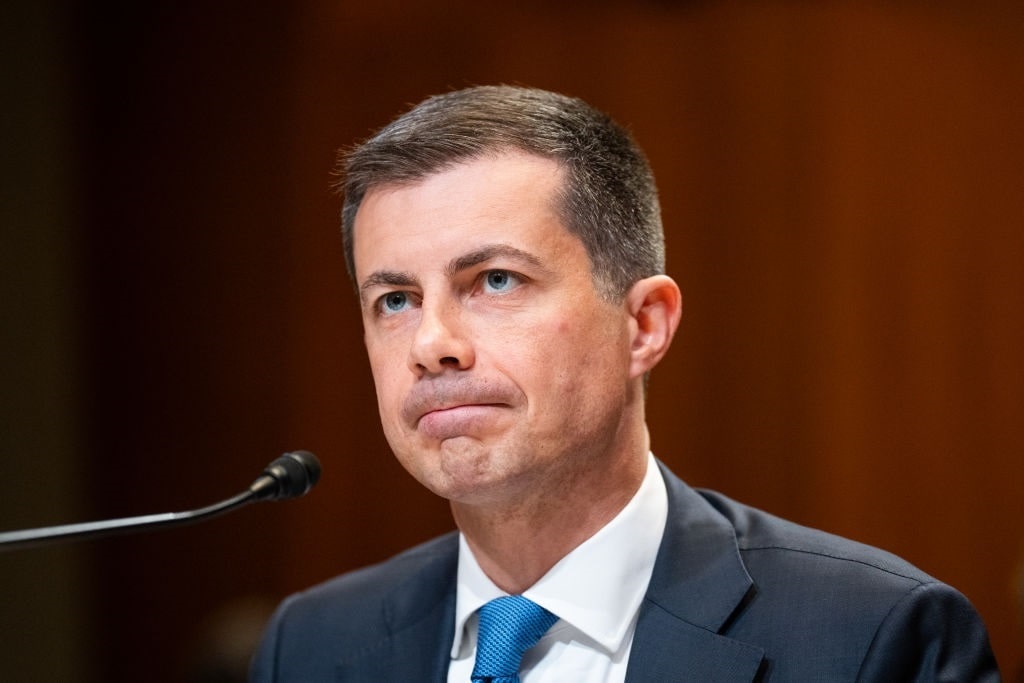What has Secretary of Transportation Pete Buttigieg done in the past three-and-a-half years? Some might say not much of anything substantial. Under Secretary Butigieg’s watch, barges have obliterated bridges, train derailments have resulted in toxic poisoning, and airplanes were diverted for all sorts of mechanical errors. Only “seven or eight” EV charging stations have been completed, although the goal is half a million by the decade’s end. What is stopping all those Build Back Better promises from President Joe Biden? According to his pal Pete, it’s climate change.
 You must blame the lack of forward movement on something, right? The secretary, during a previously recorded interview on Face the Nation, explained to host Margaret Brennan that what we have in America is crazy weather created by that scary catch phrase, climate change, and a priority we should embrace is to “continually refresh” to keep transportation safe. “Continually refresh” might be spaghetti thrown against the wall for the cause du jour. “This is something that has to continually evolve. Our climate is evolving.”
You must blame the lack of forward movement on something, right? The secretary, during a previously recorded interview on Face the Nation, explained to host Margaret Brennan that what we have in America is crazy weather created by that scary catch phrase, climate change, and a priority we should embrace is to “continually refresh” to keep transportation safe. “Continually refresh” might be spaghetti thrown against the wall for the cause du jour. “This is something that has to continually evolve. Our climate is evolving.”
Buttigieg then pivoted to the latest transportation nightmare: deadly turbulence. “Our policies and our technology and our infrastructure have to evolve accordingly, too,” Buttigieg claimed. “This is all about making sure that we stay ahead of the curve, keeping aviation as safe as it is.”
Turbulence Is Nothing New
Buttigieg’s point of reference was the hurly-burly that occurred on a Qatar Airways flight from Doha to Dublin, resulting in a dozen injured passengers. “Turbulence is an irregular motion of the air resulting from eddies and vertical currents,” explains the National Weather Service (NWS). “It may be as insignificant as a few annoying bumps or severe enough to momentarily throw an airplane out of control or to cause structural damage.”
There are four types of turbulence, according to the NWS:
- Mechanical Turbulence is friction between the air and the ground.
- Thermal (Convective) Turbulence can also be expected on warm summer days when the sun heats the earth’s surface unevenly.
- Frontal Turbulence: The lifting of the warm air by the sloping frontal surface and friction between the two opposing air masses.
- Wind Shear is the change in wind direction and/or wind speed over a specific horizontal or vertical distance.
“Magnificently complex factors interact to create turbulence,” says Dr Guido Carim Jr., head of Griffith Aviation at Griffith University. The former pilot says even bushfires can cause it. “Radar technology to detect turbulence is improving, but, despite all the instruments onboard, we cannot accurately predict where and when turbulence will be.”
Yet somehow, climate alarmists have taken this accusation from the Biden administration as a reason to keep up the infrastructure overhaul and stay ahead of what weather changes are next. The federal government’s focus remains intense on the issue: On May 16, President Joe Biden reauthorizing the Severe Turbulence Research and Development Act under the current Federal Aviation Administration.
But all Buttigieg’s pivots to climate change as a cause for the recent flight problems – or the other transportation-related issues, for that matter – seem to be deflection from the reality of what is happening within his department: Nada.
Buttigieg Blathers
The Inflation Reduction Act of 2022 earmarked a hefty $7.5 billion for EV stations across the country, but what was accomplished by the end of 2023? Little to nothing. Oh, but you must know they are working on it. The secretary hinted about big things to come in the somewhat trying interview with Brennan on Face the Nation. Here’s a snippet:
SECRETARY BUTTIGIEG: Now, in order to do a charger, it’s more than just plunking a- a small device into the ground, there’s utility work, and this is also, really, a new category of federal investment. But we’ve been working with each of the 50 states, every one of them is getting formula dollars to do this work–
MARGARET BRENNAN: Seven or eight, though?
SECRETARY BUTTIGIEG: –Engaging them and the first handful- again, by 2030, 500,000 chargers. And the very first handful of chargers are now already being physically built. But again, that’s the absolute very, very beginning stages of the construction to come.
MARGARET BRENNAN: Right. But- but that gets to the point about not being able to make long-distance travel possible quickly if you don’t have the infrastructure there to support it.
It was uncomfortable for Mr. Secretary to be dissected by the once very supportive corporate media. His problems involve billions spent on projects that Americans cannot touch, see, or feel in real-time, and his best excuse for inefficiency is climate change. Some of us call it weather, but a lack of getting things accomplished on the rails, in the air, on the highways, bi-ways, and waterways isn’t going to appear magically come election day.




